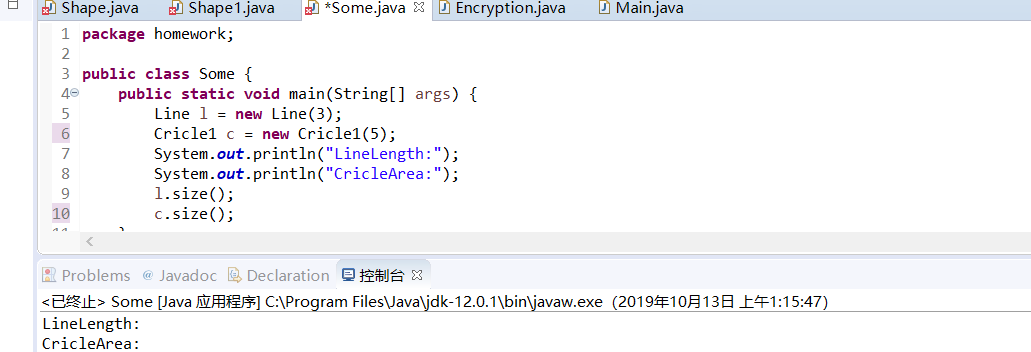第七周课程总结
1.java异常
try{
//有可能出现异常的语句
}catch(异常类 异常对象){
//编写异常的处理对象
}[catch(异常类 异常对象){
//编写异常的处理对象
}catch(异常类 异常对象){
//编写异常的处理对象
}......]
[finally{
一定会运行到的程序代码;
}]
2.throws关键字
实验五 类的继承
一、 实验目的
(1) 理解抽象类与接口的使用;
(2) 了解包的作用,掌握包的设计方法。
二、 实验要求
(1) 掌握使用抽象类的方法。
(2) 掌握使用系统接口的技术和创建自定义接口的方法。
(3) 了解 Java 系统包的结构。
(4) 掌握创建自定义包的方法。
三、 实验内容
(一)抽象类的使用
1. 设计一个类层次,定义一个抽象类--形状,其中包括有求形状的面积的抽象方法。 继承该抽象类定义三角型、矩形、圆。 分别创建一个三角形、矩形、圆存对象,将各类图形的面积输出。
注:三角形面积s=sqrt(p(p-a)(p-b)*(p-c)) 其中,a,b,c为三条边,p=(a+b+c)/2
2.编程技巧
(1) 抽象类定义的方法在具体类要实现;
(2) 使用抽象类的引用变量可引用子类的对象;
(3) 通过父类引用子类对象,通过该引用访问对象方法时实际用的是子类的方法。可将所有对象存入到父类定义的数组中。
(二)使用接口技术
1. 定义接口Shape,其中包括一个方法size(),设计“直线”、“圆”、类实现Shape接口。分别创建一个“直线”、“圆”对象,将各类图形的大小输出。
2. 编程技巧
(1) 接口中定义的方法在实现接口的具体类中要重写实现;
(2) 利用接口类型的变量可引用实现该接口的类创建的对象。
四、 实验过程(请自己调整格式)
(一)抽象类的使用
1. 设计一个类层次,定义一个抽象类--形状,其中包括有求形状的面积的抽象方法。 继承该抽象类定义三角型、矩形、圆。 分别创建一个三角形、矩形、圆存对象,将各类图形的面积输出。
注:三角形面积s=sqrt(p(p-a)(p-b)*(p-c)) 其中,a,b,c为三条边,p=(a+b+c)/2
2.编程技巧
(1) 抽象类定义的方法在具体类要实现;
(2) 使用抽象类的引用变量可引用子类的对象;
(3) 通过父类引用子类对象,通过该引用访问对象方法时实际用的是子类的方法。可将所有对象存入到父类定义的数组中。
实验源码:
package homework;
abstract class Shape {
public abstract double getArea();
public static void main(String[] args) {
Triangle t = new Triangle(3,4,5);
Rectangle r = new Rectangle(4,5);
Cricle c = new Cricle(5);
System.out.println("TriangleArea:"+t.getArea());
System.out.println("RectangleArea:"+r.getArea());
System.out.println("CricleArea:"+c.getArea());
}
}
class Triangle extends Shape{ //三角形
private double length;
private double width;
private double height;
Triangle(double length, double width, double height){
this.length = length;
this.width = width;
this.height = height;
}
public double getArea() {
double result = (length + width + height)/2;
return Math.sqrt(result*(result-length)*(result-width)*(result-height));
}
}
class Rectangle extends Shape{ //矩形
private double length;
private double width;
Rectangle(double length, double width){
this.length = length;
this.width = width;
}
public double getArea() {
return length*width;
}
}
class Cricle extends Shape{ //圆形
private double radius;
Cricle(double radius){
this.radius = radius;
}
public double getArea() {
return Math.PI*Math.pow(radius,2);
}
}
实验中遇到的问题:在最开始看题目的时候有点没思路,不知道怎样将继承子类放入抽象类中(果然放了个国庆假==重读)
解决办法:助教热心帮我解答了,中间加上子类的属性和构造方法还有主函数调用

实验结果:

(二)使用接口技术
1.定义接口Shape,其中包括一个方法size(),设计“直线”、“圆”、类实现Shape接口。分别创建一个“直线”、“圆”对象,将各类图形的大小输出。
2.编程技巧
(1) 接口中定义的方法在实现接口的具体类中要重写实现;
(2) 利用接口类型的变量可引用实现该接口的类创建的对象。
实验源码:
package homework;
public class Some {
public static void main(String[] args) {
Line l = new Line(3);
Cricle1 c = new Cricle1(5);
System.out.println("LineLength:");
System.out.println("CricleArea:");
l.size();
c.size();
}
}
interface Shape1 {
double size();
}
class Line implements Shape1{
private double l;
public Line(double l) {
this.l = l;
}
public double size() {
return l;
}
}
class Cricle1 implements Shape1{
private double c;
public Cricle1(double c) {
this.c = c;
}
public double size() {
return Math.PI*Math.pow(c,2);
}
}
实验中遇到的问题:
无
实验结果:

四、 结论
1.在写题的过程中发现第一题可以有三种不同的输出方式
①普通方法
public static void main(String[] args) {
Triangle t = new Triangle(3,4,5);
Rectangle r = new Rectangle(4,5);
Cricle c = new Cricle(5);
System.out.println("TriangleArea:"+t.getArea());
System.out.println("RectangleArea:"+r.getArea());
System.out.println("CricleArea:"+c.getArea());
}
②百度上看到的:构造对象时创建数组,再将内容直接输出
Shape s[] = new Shape[3]; 创建三个类
s[0] = new Triangle(4,5,6);
s[1] = new Rectangle(4,5);
s[2] = new Circle1(47);
for (int i=0;i<=2;i++) 利用for循环依次输出它们的面积
{
System.out.println(s[i].getArea());
}
③从助教处学到的简便方法:不创建对象直接用new输出
public class Main {
public static void main(String[] args) {
System.out.println(new triangle(3, 4, 5).Area());
System.out.println(new rectangle(1, 1).Area());
System.out.println(new circle(1).Area());
}
}